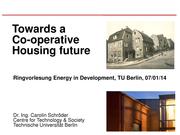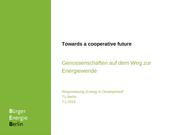Difference between revisions of "Towards a Cooperative Future"
***** (***** | *****) |
***** (***** | *****) |
||
| Line 59: | Line 59: | ||
<br/> | <br/> | ||
| + | |||
= Current Renaissance of Cooperatives in the Form of Energy Cooperatives = | = Current Renaissance of Cooperatives in the Form of Energy Cooperatives = | ||
| − | Currently, a renaissance of the organisational form of the cooperative can be observed in the energy sector in relation to the plannig, financing, installation, operation and maintenance of RES, such as Wind Energy Projects or big-scale Photovoltaic | + | Currently, a renaissance of the organisational form of the cooperative can be observed in the energy sector in relation to the plannig, financing, installation, operation and maintenance of RES, such as Wind Energy Projects or big-scale Photovoltaic Installations. Primarily, energy production and supply was subject to federal control and monopolisation. In Germany, with the liberalisation and ultimately with the enforcement of the EEG, the energy market now is accessible for various actors and stakeholders, reaching down to the single individual. This is the actual breeding-ground for business-modells, such as Energy Cooperatives. |
Thereof three branches of business are well-established.<br/> | Thereof three branches of business are well-established.<br/> | ||
| Line 87: | Line 88: | ||
From another point of view, this development means a shift of property proportions in the energy production, according to the general steep increase in RES installations and energy production capacity.<br/> | From another point of view, this development means a shift of property proportions in the energy production, according to the general steep increase in RES installations and energy production capacity.<br/> | ||
| − | Hence, the original federal monopoly in the energy sector, first substituted by private monopolies, has now in fact become subject to a civil liberalisation. This is another interpretation of the meaning of "Energy Autonomy", on a micro-level scale. Nevertheless, along with this independency and choice, also comes responsibility and a mandate for coordination, decision-making, regulation and control. This | + | Hence, the original federal monopoly in the energy sector, first substituted by private monopolies, has now in fact become subject to a civil liberalisation. This is another interpretation of the meaning of "Energy Autonomy", on a micro-level scale. Nevertheless, along with this independency and choice, also comes responsibility and a mandate for coordination, decision-making, regulation and control. This challenge remains to be mastered for a successful decentralisation and autonomy, refered to as Energy Transformation. |
| + | [[Category:Renewable_Energy]] | ||
| + | [[Category:Conference_Documentation]] | ||
| + | [[Category:Energy_Use]] | ||
[[Category:University]] | [[Category:University]] | ||
| − | |||
| − | |||
| − | |||
Revision as of 14:37, 31 October 2014
| ► | Back to the Lecture Series: Energy in Development |
Presentations (second in German)
Overview
The first presentation deals with the renaissance of the enterprise organisational form of cooperatives in the energy sector, so called Energy Cooperatvies through decentralized Renewable Energy Sources (RES). Therefore the historical roots and original motives of the cooperative movement are shortly depicted. Subsequently the phenomena of Energy Cooperatives in the current context of the German Energy Transition is subject to discussion.
Reflection on the Historical Roots of Coperatives
The central figure in the origins of cooperatives is Robert Owen, a welsh social reformer and entrepreneur. As early as 1799 he first introduced consumer cooperatives. These cooperatives originally realized the provision and supply of groceries.
In Germany the first cooperative structures appeared around 1846 in the agricultural sector in rural areas. Farmers utter dependency on profitable harvests left them in a vulnerable position to landlords and great land owners. Consequently a cooperative organisation served to overcome this dependency and introduced the concept of subsidarian aid. Farmers conjuction and cooperation empowered them to independently organize credit lending mechanisms, i.e. in order to finance seeds. This, for example, was the intention of the "Wegebuscher Brotverein". Founded as a friendly society it quickly developed into a cooperative structure.
Similarily, first forms of cooperative organisations emerged in cities and urban areas synchroncally around the year 1847. This is widely connected to Hermann Schulze-Delitzsch who also is believed to have been the driving force in the introduction of a cooperative law and order. With his "Delitzscher Vorschuss-Verein" he organized financing through the emission of stocks and therewith helped to establish subsidarian financial allocation.
This sums up in the first central idea and motivation of cooperatives which is self-help in times and situations of hardship through an organized and systematic union of peers and peer-groups. In addition frequently suppliers and producers are integrated into the concept.
Some of the main characteristics are:
- local and regional structures
- democratic principe, i.e. one vote per stakeholder only
- solidarian accountability
- alternative ownership-structure within a classical corporate structure
Also typical and wide-spread is the support of education in order to break the cycle of dependency and the lack of consciousness about this situation. Robert Owen saw education as a central concern because he was convinced that "a cooperatives is an union of a special kind, that is for and upmost based on people rather than on capital".
Current Renaissance of Cooperatives in the Form of Energy Cooperatives
Currently, a renaissance of the organisational form of the cooperative can be observed in the energy sector in relation to the plannig, financing, installation, operation and maintenance of RES, such as Wind Energy Projects or big-scale Photovoltaic Installations. Primarily, energy production and supply was subject to federal control and monopolisation. In Germany, with the liberalisation and ultimately with the enforcement of the EEG, the energy market now is accessible for various actors and stakeholders, reaching down to the single individual. This is the actual breeding-ground for business-modells, such as Energy Cooperatives.
Thereof three branches of business are well-established.
These are
- production of energy
- trading of energy
- distribution of energy
All three fields of activity have seen a considerable growth in recent years.
Development of number of Energy Cooperations in Germany
From another point of view, this development means a shift of property proportions in the energy production, according to the general steep increase in RES installations and energy production capacity.
Hence, the original federal monopoly in the energy sector, first substituted by private monopolies, has now in fact become subject to a civil liberalisation. This is another interpretation of the meaning of "Energy Autonomy", on a micro-level scale. Nevertheless, along with this independency and choice, also comes responsibility and a mandate for coordination, decision-making, regulation and control. This challenge remains to be mastered for a successful decentralisation and autonomy, refered to as Energy Transformation.





















